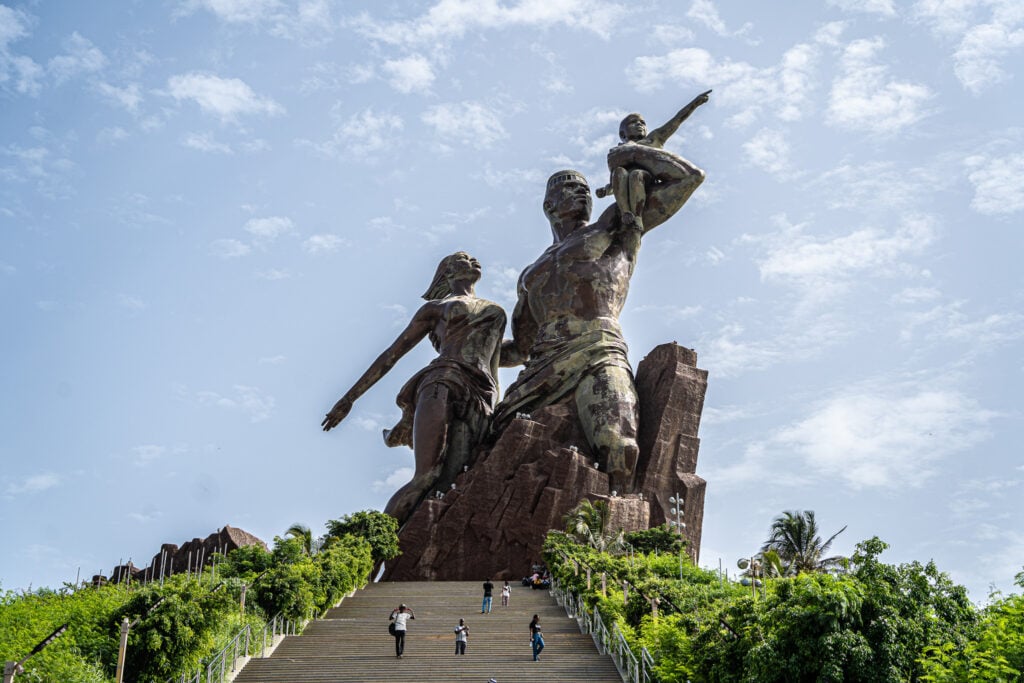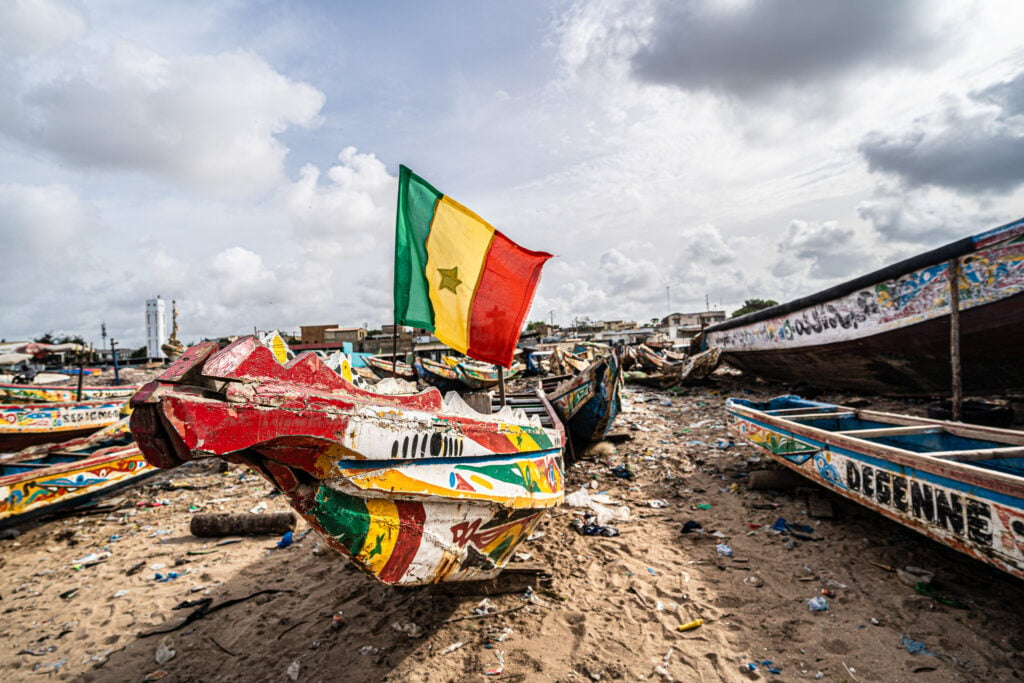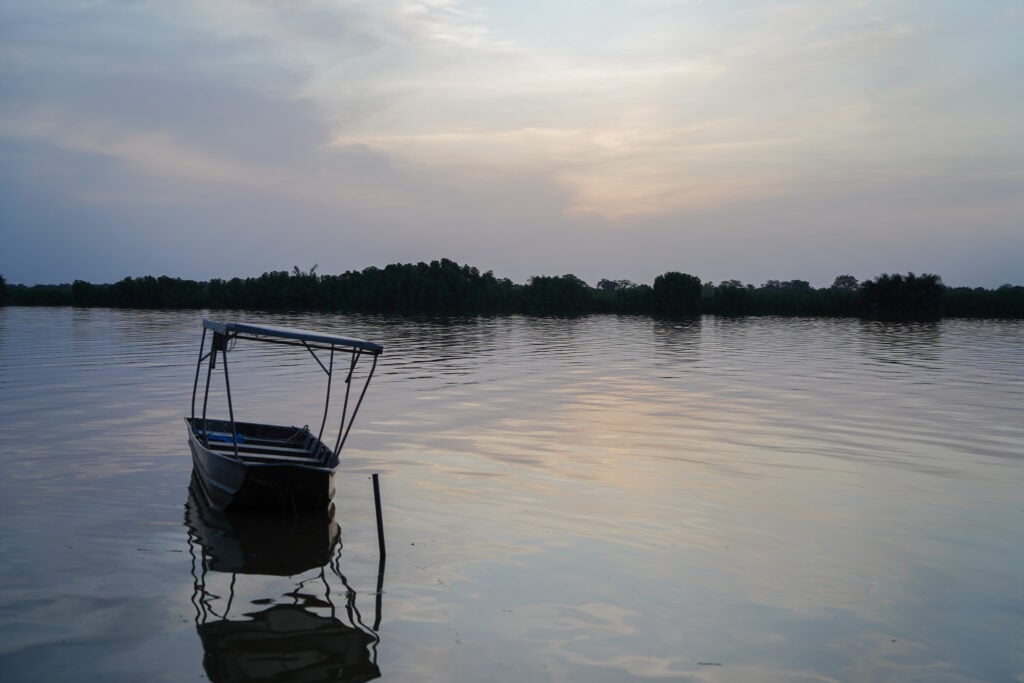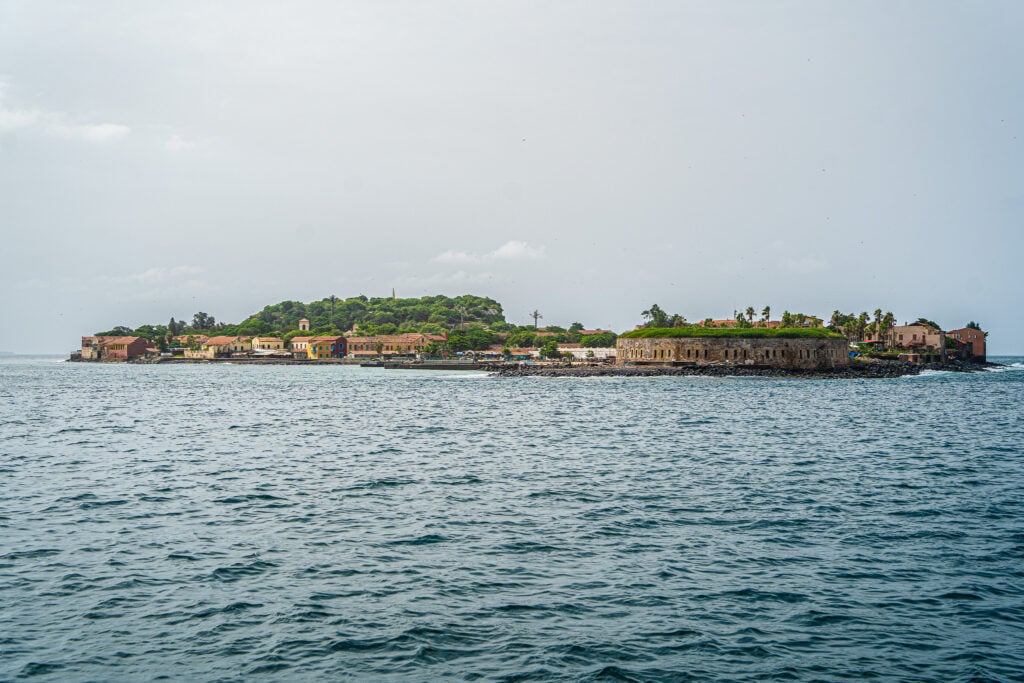Where is Senegal? Is Senegal in West Africa? Which countries does Senegal share borders with? Here’s everything you need to know about Senegal’s geography.
Senegal truly is the gateway to West Africa. Long hailed as one of the region’s most stable nations, the nation is home to landscapes that reach from the deserts of the Sahara to the wetlands of Casamance. With a long coastline extending along the Atlantic Ocean, Senegal shares borders with Mauritania, Mali, Guinea, and Guinea-Bissau, while the country almost completely envelopes the smaller nation of The Gambia.
Dakar, the country’s capital, is known for its monumental museums and statues. Sitting at the most westerly point on the African continent, Senegal is at the crossroads of the western hemisphere. Senegal’s geography ensures the country has long been an important cultural and economic hub, a fact shown through history as powers as wide-ranging as the Wolof Empire and the French colonialists have vied for control.
In this article, we explain exactly where Senegal is, where its borders begin, and where they end, so you can learn more about this West African before your next adventure. Where’s Senegal? Here’s everything you need to know.
Table of Contents
Where is Senegal?
Senegal is a sovereign country located in West Africa. It is bordered by the North Atlantic Ocean to the west, Mauritania to the north and northeast, Mali to the east, Guinea to the southeast, and Guinea-Bissau to the southwest. Senegal also surrounds The Gambia on three sides, except for its western coast along the Atlantic Ocean. The country is known for its rich history, diverse cultures, and significant role in regional geopolitics, particularly in West Africa. Its capital and largest city is Dakar, situated on the Cape Verde Peninsula on the country’s western coast.
Dakar, Senegal’s capital, is situated on the Cape Verde Peninsula (or Cap-Vert), jutting into the Atlantic. This positioning has historical and contemporary importance, making Dakar a pivotal maritime and cultural hub. Senegal’s location has profoundly influenced its historical trajectory, playing a central role in the transatlantic slave trade and later in the struggle for African independence and identity.
The country’s location at the westernmost point of the African mainland has also made it a key player in various trans-Saharan and transatlantic interactions, shaping its culture, economy, and politics. This strategic positioning continues to influence Senegal’s role in regional and international affairs, particularly in West African geopolitics.

Read more: How Many Countries Are in West Africa? Everything You Need to Know.
Facts about Senegal
Here are the most important facts to know about Senegal:
- Official Name: Republic of Senegal
- Capital: Dakar
- Geographical Location: West Africa
- Area: Approximately 196,722 square kilometres
- Population: Estimated at over 16 million
- Official Language: French
- Major Local Languages: Wolof, Pulaar, Serer, Mandinka, Jola, and others
- Government Type: Semi-presidential republic
- Currency: West African CFA franc (XOF)
- Economy: Predominantly based on agriculture, mining, and fishing; emerging sectors include tourism and services
- Major Religions: Predominantly Islam, with Christian and indigenous religious minorities
- Time Zone: Greenwich Mean Time (GMT)
- International Dialing Code: +221
- Climate: Tropical with a dry and a rainy season
- Key Historical Facts: Former French colony, gained independence in 1960; significant role in African political and cultural movements
- UNESCO World Heritage Sites: Include the Island of Gorée, Niokolo-Koba National Park, Bassari Country, and others
Read more: How Many Countries in North Africa? Everything You Need to Know.
What’s the capital of Senegal?
Dakar, the capital of Senegal, stands on the Cape Verde Peninsula, extending outwards into the Atlantic Ocean. This city, the largest in Senegal, functions as the central point for government, commerce, and culture. Its history is marked by its strategic importance as a port during the era of European exploration and colonialism. Dakar’s role was pivotal in the transatlantic slave trade, serving as a key transit point.
In the contemporary era, Dakar reflects a fusion of its historical legacy with modern influences. The city’s streets display a mix of colonial architecture and newer buildings. Its markets, like Marché Kermel, are bustling with activity, offering a glimpse into the local lifestyle and Senegal’s culinary diversity.
Dakar is also a significant cultural centre in Africa, known for hosting events like the Dakar Biennale, which showcases contemporary African art. The city’s history as a colonial capital and a centre for anti-colonial struggle has shaped its unique identity, making it a city that is not only Senegal’s administrative heart but also a repository of its complex history and cultural dynamism.

Read more: How Many Countries Are in Central Africa? Everything You Need to Know.
How many regions are there in Senegal?
Senegal is divided into 14 regions, each headed by a regional council. These regions are further subdivided into departments and communes, which are the basic units of local governance in the country. The regions in Senegal are designed to facilitate administrative efficiency and regional development, reflecting the country’s diverse geographical and cultural landscapes.
- Dakar
- Diourbel
- Fatick
- Kaffrine
- Kaolack
- Kédougou
- Kolda
- Louga
- Matam
- Saint-Louis
- Sédhiou
- Tambacounda
- Thiès
- Ziguinchor

Read more: How Many Countries Are in Africa? Everything You Need to Know.
Is Senegal in West Africa?
Senegal is indeed situated in West Africa, occupying a prominent position on the continent’s westernmost edge. This strategic location has historically made it a crucial point for maritime trade and cultural exchanges across the Atlantic.
Senegal’s western border is lined by the expansive North Atlantic Ocean, providing access to maritime routes. The country shares land borders with Mauritania to the north, Mali to the east, and Guinea and Guinea-Bissau to the south.
Its unique geographical feature includes the encirclement of The Gambia on three sides. Senegal’s position in West Africa has significantly influenced its historical, cultural, and economic development, making it a key player in the West African region.

Read more: 14 Best Things to Do in Dakar, Senegal
Is Senegal the westernmost point in Africa?
Senegal is notable for hosting the westernmost point of the African continent. This point is located at Cap Vert, on the Peninsula of the same name, where the capital city, Dakar, is situated.
The significance of this geographic position extends beyond mere cartography; it has historical and cultural implications. Cap Vert’s proximity to the Atlantic Ocean made it a crucial hub during the transatlantic slave trade and later, a key point in maritime navigation and commerce.
Today, this westernmost location continues to influence Senegal’s climate, trade, and its role as a gateway between Africa and the rest of the world, especially in maritime connections.

Read more: 15 Best Places to Visit in Senegal
What’s Senegal’s geography like?
Senegal’s geography is marked by a variety of landscapes, reflecting its location in West Africa. Here are the key geographical features you’ll find on a trip here:
- Coastline: Senegal has a significant coastline along the North Atlantic Ocean, characterised by sandy beaches, particularly around the capital, Dakar. This coastal area is crucial for fishing, tourism, and maritime trade.
- The Sahel Region: The northern part of Senegal is part of the Sahel, a semi-arid region that stretches across Africa. This area transitions from the Sahara desert in the north to more fertile lands in the south.
- Rivers: The Senegal River forms the natural border with Mauritania and is a key water source. Other important rivers include the Casamance and the Gambia River.
- Climate: The country experiences a tropical climate with distinct dry and wet seasons. The south is more humid and receives more rainfall, supporting diverse vegetation and agriculture.
- Terrain: The interior of Senegal consists mainly of rolling plains, with some hills in the southeast. The southeastern region, particularly around Kédougou, features higher elevations, including the Fouta Djallon foothills.
- Flora and Fauna: The country’s varied climates support different types of vegetation, from Sahelian scrub in the north to tropical forests in the south. Wildlife is diverse, including species adapted to both arid and humid environments.

Read more: Where is The Gambia? Everything You Need to Know.
Is Senegal a sovereign nation?
Senegal is indeed a sovereign nation. It achieved its independence from French colonial rule on April 4, 1960, marking a significant transition from a period of colonial governance to self-determination and autonomy. Since then, Senegal has been recognised internationally as an independent state, with its own government, legal system, and defined national boundaries.
As a sovereign nation, Senegal exercises full control over its internal and external affairs. It has established its own constitution, which outlines the framework for its political and legal systems, and guides its domestic and foreign policies. Senegal’s government is structured as a democratic republic, with a president serving as the head of state and government.
The country is an active member of several international organizations, including the United Nations, the African Union, and the Economic Community of West African States (ECOWAS). These memberships underscore Senegal’s commitment to participating in global dialogues and collaborations.
Senegal’s sovereignty is reflected in its ability to engage with other nations on equal footing, contribute to international peacekeeping efforts, and play a significant role in regional affairs in West Africa. Its independence has allowed it to pursue a path of development that aligns with its own cultural, economic, and social objectives, showcasing its identity as a free and sovereign nation.

Read more: How to Travel From Senegal to The Gambia (Including Overland Border Crossings)
Is The Gambia in Senegal?
The Gambia is not part of Senegal; it is a separate, sovereign nation. However, its geographical relationship with Senegal is unique and noteworthy, which often leads to confusion about its relationship with its larger neighbour.
The Gambia is almost entirely surrounded by Senegal, save for its small Atlantic coastline. This peculiar geographic situation makes The Gambia the smallest country within mainland Africa, and its borders are a result of historical demarcations set during the colonial era.
Despite their distinct national identities, Senegal and The Gambia share deep cultural, historical, and linguistic ties. The two countries have intertwined histories, with colonial powers drawing arbitrary borders that divided ethnic groups and communities. These shared cultural aspects foster a sense of kinship between their peoples.
In recent years, efforts have been made to strengthen cooperation and integration between Senegal and The Gambia. Initiatives like the Senegambia Confederation in the 1980s, although short-lived, and more recent agreements on economic and security collaboration, reflect the strong bond between the two nations, despite being separate sovereign entities.

Read more: 14 Best Places to Visit in The Gambia
What languages do they speak in Senegal?
In Senegal, a variety of languages are spoken, reflecting the country’s rich cultural diversity. The official language is French, a legacy of its colonial history, which is used in government, media, and education. However, many indigenous languages are widely spoken and integral to daily life and cultural expression.
The most widely spoken local language is Wolof, which serves as a lingua franca across different ethnic groups. Other significant languages include Pulaar (or Fulani), Serer, Mandinka, Jola, and Soninke.
These languages are not only used in daily communication but also play a crucial role in maintaining and expressing the country’s diverse cultural heritage. Additionally, English is increasingly being learned and used, particularly in the business and tourism sectors.

Read more: How ‘Teranga’ Inspires Conservation and Rewilding in Senegal’s Saloum Delta
So, where is Senegal?
In conclusion, Senegal’s position on the westernmost edge of Africa is not just a point on a map, but a reflection of its rich history, diverse culture, and strategic importance.
From the busy streets of Dakar to the tranquil shores of the Atlantic, Senegal offers a unique experience that intertwines the past with the present. Its location has played a pivotal role in shaping its identity, making it not just a geographic location, but a crucial player in the tapestry of African and world history.
Whether you are a student of geography, a lover of culture, or simply a curious traveller, understanding where Senegal is located is the first step in appreciating the depth and richness of this remarkable West African nation.

FAQ: Where is Senegal?
Here’s an FAQ on the topic: ‘Where is Senegal?’:
Q1. Where is Senegal located?
Senegal is located in West Africa. It’s situated on the westernmost edge of the African continent, bordering the North Atlantic Ocean.
Q2. What countries border Senegal?
Senegal is bordered by Mauritania to the north, Mali to the east, Guinea to the southeast, and Guinea-Bissau to the southwest. It also almost completely surrounds The Gambia.
Q3. What is the capital of Senegal?
The capital of Senegal is Dakar, which is located on the Cape Verde Peninsula along the Atlantic coast.
Q4. What is the significance of Senegal’s location?
Senegal’s location has historical importance due to its proximity to European trade routes and its role in the transatlantic slave trade. Its coastal position also makes it a key player in maritime activities in West Africa.
Q5. What is the climate like in Senegal?
Senegal has a tropical climate, with a distinct wet and dry season. The climate varies from semi-arid in the north to more humid in the south.
Q6. What are the major geographical features of Senegal?
Major geographical features include its Atlantic coastline, the Senegal River, the Sahel region in the north, and various national parks and wildlife reserves.
Q7. What is the size of Senegal?
Senegal covers an area of approximately 196,722 square kilometers.
Q8. How is Senegal’s geography beneficial to the country?
The geography supports agriculture, particularly in the more fertile south, and fishing along the coast. It also fosters tourism, thanks to its diverse landscapes and rich cultural heritage.
Q9. Is Senegal a popular tourist destination?
Yes, Senegal is known for its rich culture, historical sites, and natural beauty, making it an attractive destination for tourists.
Q10. What languages are spoken in Senegal?
The official language is French, but many indigenous languages such as Wolof, Pulaar, and Serer are widely spoken.



Recent Comments